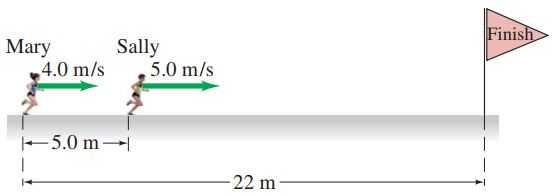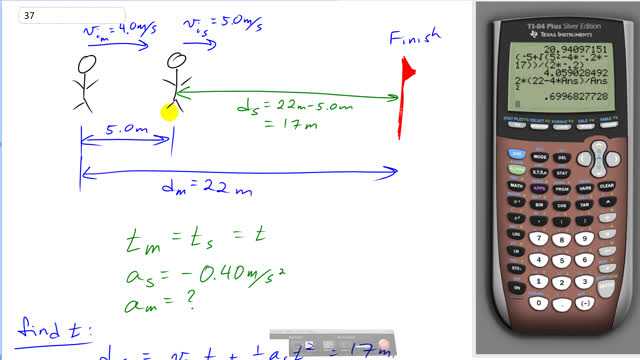
Mary and Sally are in a foot race (Fig. 2-39). When Mary is 22 m from the finish line, she has a speed of 4.0 m/s and is 5.0 m behind Sally, who has a speed of 5.0 m/s. Sally thinks she has an easy win and so, during the remaining portion of the race, decelerates at a constant rate of to the finish line. What constant acceleration does Mary now need during the remaining portion of the race, if she wishes to cross the finish line side-by-side with Sally?


In order to watch this solution you need to have a subscription.
This is Giancoli Answers with Mr. Dychko. So Sally has only 17 meters to go a total distance of 22 meters for Mary minus the 5 meter lead she has over Mary to begin with. And based on this information, we can figure out how much time is left in the race. When Sally is decelerating at 0.40 meters per second squared or having an acceleration of negative 0.4, we can figure out the time it will take Sally to finish and that's the amount of time that Mary has to finish at the same time. So first figure out the total time in the race the time that Mary and the time that Sally are gonna be running for is exactly the same because they are gonna finish at the same time so we don't need any subscripts on t, we'll just instead of t m and t s, we'll just call it t and the distance that Sally's gonna cover is v initial times t plus one-half at squared and we have Sally's information plugged into this formula and that equals 17 meters and minus 17 from both sides and then we end up with this formula here and we'll solve it for t after we substitute in Sally's acceleration of negative 0.4 meters per second squared and her initial velocity of 5 meters per second positive because it's to the right and we are defining right as positive and so that's negative 0.2 t squared plus 5t minus 17 and we'll use the quadratic equation to solve that where b is the coefficient of the linear term so that's 5 and so we'll have negative 5 plus square root of 5 squared minus 4 times the coefficient of the squared term so that's negative 0.2 times negative 17, the constant term c divided by 2 times negative 0.2 and that gives 4.059 seconds. Now if you had a minus sign here, you would have gotten an answer of 20.941 seconds and we are gonna reject that because the meaning of it is, you know, if Sally were to run past the finish line and continue running and decelerate and decelerate and eventually to the point where her velocity became negative and then returned back to the finish line that's what would take 20.9 seconds and we are not interested in that, we are interested in the first time that she crosses the finish line not the second time that she crosses like we don't care about the time when she crosses and then comes back we care about the time when she initially gets there which is 4.06 seconds. Okay so now that we know this time, we'll figure out the distance that or the acceleration of Mary and so we know her distance and so we use this formula, she has 22 meters to go and we'll solve this for acceleration by taking this to the right-hand side and well what did I do, I guess I went this to the left-hand side to make it to minus there and then flip the sides around so that we have the unknown on the left and then divide both sides by t squared and multiply both sides by 2. And then we end up with this for the acceleration and so that's 2 times the distance Mary has to go—22 meters— minus her initial speed of 4 meters per second times the total time she'll spend running— 4.059 seconds— and divide by the time squared giving an acceleration required of 0.7 meters per second squared.
Hi. Sr. Why tm=ts
How you figuarated that Sally and Mary have the same time.
Hi joseotilio25, please see my answer to your question about why the trains had the same elapsed time here: https://www.giancolianswers.com/giancoli-physics-7th-edition-solutions/…. Instead of trains, this question has Sally and Mary, but otherwise it's the same idea.
Good luck!
Mr. Dychko